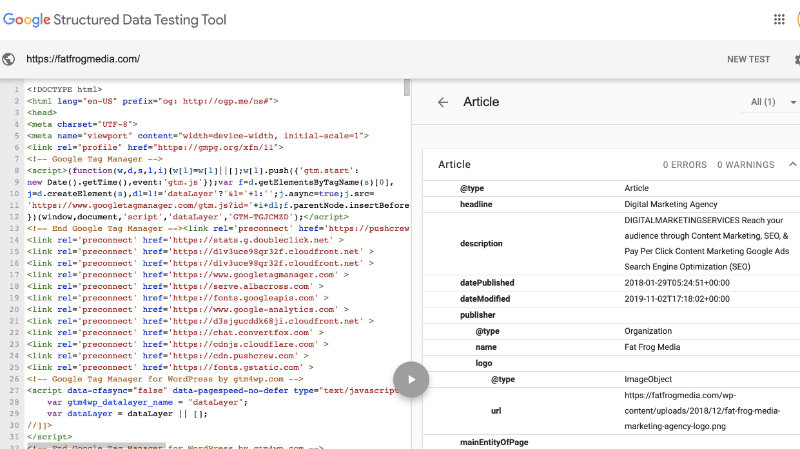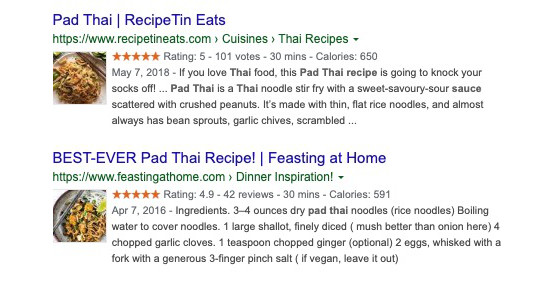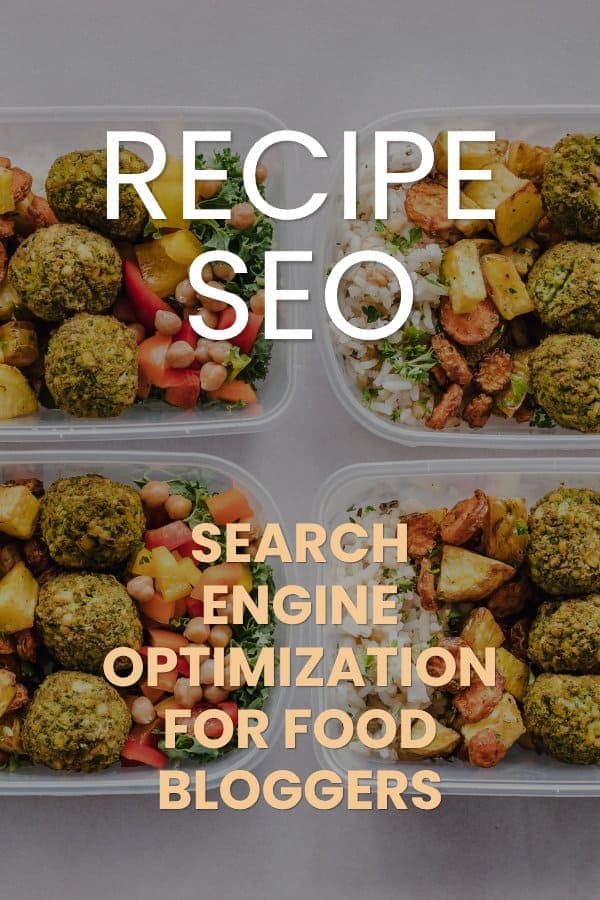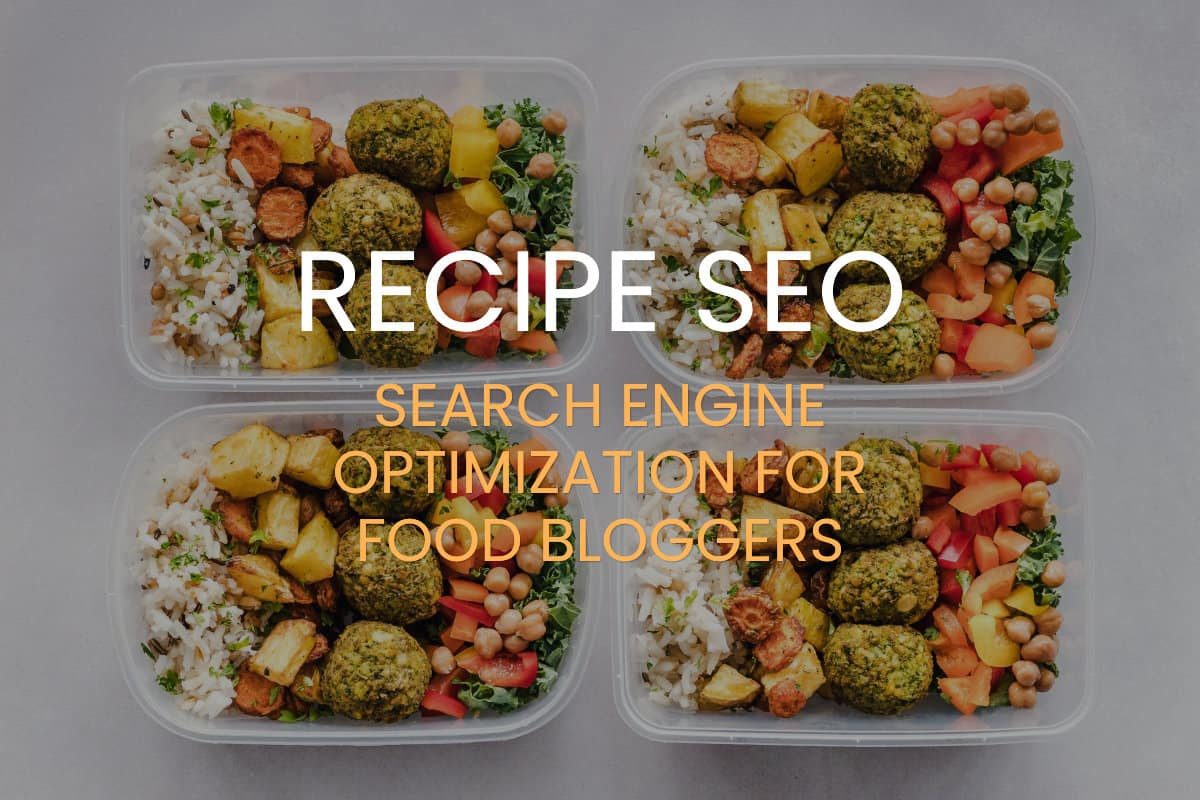At Fat Frog Media, we manage a successful food blog as a side project. And we’ve learned a lot from practical experiences about what works on food blogs. Food blog SEO is a particular case. And we will let you in on some secrets. SEO is a process. It’s not a quick fix solution for bad content. Here’s a guide to making sure that search engines love your food blog and that every recipe reaches its full potential.
We’ve learned a lot from practical experiences about what works on food blogs
- Is Long-Form Still The Best Form?
- Use one of the top WordPress recipe plugins
- Let AI lend a hand
- Include Long tail keywords
- Compete When It Makes Sense
- Use Structured Data
- Use Video
- Titles and Meta Descriptions
- Use Frequently Asked Questions
- Keep your URLs tidy
- Optimize your images
- Embrace voice search SEO
- Final Food Blogger SEO tips
Is Long-Form Still The Best Form?
Despite what you might have heard, longer content can still work well for recipe SEO. However, Google is moving towards a model of providing instant answers to satisfy user intent.
Ignore the haters that complain about long recipe posts. Food bloggers can still write the background information to a recipe. Many readers are interested in this. It adds a human touch. But make sure all of the background information, history, and anecdotes are relevant and provide value. Everything else is fluff. And we don't want any fluff.
If you publish a bare recipe card, it might rank in the recipe carousel but the post won't appear in the search results. The content of your post and the recipe card help each other rank in Google. Add context and life to a recipe so that google can understand what it’s about and who it’s for.
Add some context and life to a recipe so that google can understand what it’s about and who it’s for.
Use one of the top WordPress recipe plugins
Obviously, this only applies to WordPress users, but the vast majority of food bloggers are using the world’s most popular content management system. And why not? It’s perfect for the job and there’s a huge community of other WordPress food bloggers. WordPress is a great platform to build a good search engine optimisation strategy and many recipe plugins are designed with SEO in mind.
Three of the best recipe plugins for WordPress:
WP Recipe Maker is our weapon of choice for optimizing recipes. The plugin comes with a bewildering array of settings and options but you don’t have to use them all. But you don’t have to be an expert. The basic, default settings will present your recipes in the recommended format for recipe SEO.
A distinct feminine style dominates the WordPress themes created by Blossom Themes. Your recipe blog will look great with the Blossom templates, which are designed for lifestyle and food bloggers. In addition, the theme has some unique features you won't find anywhere else, such as front-end recipe submission, an analytics dashboard, and a floating recipe bar.
A new plugin with some great features for food bloggers: A recipe submission form allows visitors to fill out a form on your site. It allows people to submit their own recipes. The analytics dashboard helps you analyze the stats of every recipe in terms of total likes and ratings and view the recipes your readers like most. There's also a floating recipe bar to help readers prepare recipes, social sharing buttons, and detailed documentation so you'll never get lost.
Created by professional food bloggers over at Food Blogger Pro, WP Tasty is a premium plugin that has one focus, implementing the best format for your recipe so that it can be found in search.
A new recipe card tool that we're also using is Mediavine's Create. Designed for the new WordPress Gutenberg editor, this plugin is easy to use and 100% free. Simple to set up and simple to add recipes. It also looks great and works really well with WordPress.
Let AI lend a hand
You can write your recipe posts directly into WordPress but I don't recommend this. If your connection drops or you hit the wrong button, you could lose all your work. A second-best is Google Docs, which comes with some time-saving AI writing features. Docs is a perfectly good word processor and content writing tool these days.
I prefer to use Frase's multi-function tool for writing content with instant feedback, finding frequently asked questions, discovering related phrases, and pinpointing gaps in the market.
I use Frase to lay out the sections of my recipe posts and blog posts as well as add in questions that people regularly ask. Then I can write the content and use the topic score suggestions to make sure I cover everything Google expects.
There's even an AI writer which finishes your paragraphs and can even create the headings for you.
An alternative to Frase is Surfer SEO, which is one of the most popular tools for optimizing content. Surfer also has a decent keyword research tool and a very good topic research tools. The blog post or recipe post outline builder is very helpful. Surfer now has artificial intelligence tools built in and can even automate some of the writing. I would add that you really need to edit every piece of content produced.
These tools will speed up the creation process and help you outrank your competitors.
Include Long tail keywords
What are long-tail keywords? Here's an example.
Let’s say someone is searching for a way to cut sugar but still eat a delicious chocolate cake, something that their grandmother used to eat. Well, there’s no perfect solution to this one but maybe you want to introduce people to your keto-based chocolate cake, a recipe inspired by your grandmother’s cooking. How would anyone find this recipe?
Well, they might search for “sugar-free chocolate cake” or “cakes like they used to make them, but no sugar”. That’s actually how people search, especially in the days of voice search.
These are called long-tail keywords for reasons we won’t get into here but you can read more about this kind of keyword here.
Long-tail keywords will help people find your recipe for many related terms
Keywords that have fewer searches than the big (head) terms like “pasta recipe” are easier to rank in Google. It doesn't take as much work to get traffic to the keywords “vegetarian whole grain pasta recipe” because fewer people are looking for this. The main reason is there is less competition. (Not always true. Some long-tail keywords still get plenty of searches. But in general, these types of keywords are searched for less)
What’s the best way of telling if a keyword is easy to rank for?
Use a keyword tool. You can also use Keywords Everywhere, a detailed way of finding what people are looking for. Finding the right keywords for food blogs is easy if you know where to look.
Compete When It Makes Sense
I'll explain this tip using an example. Let’s say you have a great recipe for custard cakes that you know people would love to read. But let’s imagine that unfortunately nobody ever sees this recipe because it’s on page 5 of the search results for your keyword.
What do you do? The short answer is you improve the on-page SEO of the recipe page. How do you improve the on-page SEO? By analyzing your competitors and understanding what kind of language, keywords, and structure are in their blog posts. Then you get to improve your content.
Use a keyword tool to find out which keywords are the best to focus on and then check the top 10 results for your keyword. Let’s say you are trying to rank for “lemon custard cake recipe”.
(My keyword difficulty tools tell me this keyword gets around 1000 searches a month worldwide. However, it’s not an easy keyword to rank for. We’ll still use it for the purpose of this exercise.)
The next thing to do is discover the wording and phrases the top results use and see if there are similarities among them. Check the headings and title tags. Examine the image tags.
Alternatively, you could fire up a tool like Surfer SEO and let the software do the heavy lifting for you. Surfer SEO checks your competitors and audits your blog post or recipe post based on the recommendations. Google already knows what people want. Google puts the pages that best serve its customers (users of the search engine) first. If you craft your recipe content to be more in line with what Google expects, you can improve your rankings. Improved rankings equal more traffic.
Of course, if your website is not built on a strong domain (you can check that here) or you’re just getting started, it might be better to not waste too much time on difficult keywords. Look for easier ways to get to the top.
Build a fast website or have someone optimise it for you. In the last few years, the Search team at Google has been pushing for website owners to improve the speed of your site (how quickly pages load for the reader). Speed is now considered a major ranking factor.
Simply put, slower pages don’t make the top 10. And websites that are not in the first 10 results on Google get very few visitors.
Fast website = more eyeballs on your content = more successful food blog.
Speed is now considered a major ranking factor
How to make your site faster? I can’t answer this in a few lines but the first place to start is with an audit to see where the problems lie.
Use GTmetrix to check for problems.
Looking for a free audit. Check this free audit tool.
There are hundreds of different factors that might influence the page download times but two of the main ones are issues concerning render-blocking JavaScript and CSS. Fixing both of these can significantly speed up your website.
W3 Total Cache, a caching plugin for website speed, allows you to configure Javascript and CSS files so they do not impact the loading time of your website. A popular alternative is WP Rocket, which is also much easier to configure and offers some features that W3 does not. However, I've found that WP Rocket can break a website, so while it's an excellent plugin, make sure you test it extensively.
Another issue we see with food blogs is huge images. This niche is image-heavy. People want to show off the fine photography that accompanies their food creations. But uploading 5MB images directly from your DSLR camera will kill your website.
Optimize your photos by reducing the image dimensions and reducing the quality to a level where they still look amazing but they don’t eat up all your server bandwidth. Photoshop is perfectly capable of doing the work of reducing image size. For a free online alternative check out Pixlr.
Reduce image load times even further with ShortPixel, a WordPress plugin that automatically optimizes your images for devices and converts to the new web standard for fast-loading images, Webp.
Mobile phone connections are slower than desktop or laptop connections in the home or office. This is even more true for mobile phones not using a wifi network. Think about the people having to wait to download your recipe that’s weighed down with heavy images, a clunky WordPress theme, and a slow web hosting server.
Use Structured Data
What is structured data?
Simply put, structured data is a way of organizing the text and layout of your recipe so that Google understands all the features. Components like directions, ingredients, nutritional information, video, and images are important for search engines to understand your content. The easier you make it for search engines to read your content, the more love they will give it.
Structured data sounds complicated. Admittedly, it can be a pain to implement. But it’s been getting easier to add structured data to your site. There’s no longer an excuse for not having it. And the improvements in traffic and exposure that a structured data implementation can deliver makes it all worth it.
How to start?
One way is to add the code manually to every page on your website. This is the cleanest way to do it but it’s time-consuming. If you have a VA, this might be a job for them.
Structured data is a way of organising the text and layout of your recipe so that Google understands all the features
Easier than adding code is to use a tool that adds structured data to your content. There are many ways to do this and it can get quite confusing but a good plugin will do a lot of the work.
You can also use recipe plugins that format your content properly, such as WP Recipe Maker Pro.
Use Google’s Structured Data Testing Tool to see if your post, recipe, or website conforms to the standards and best practises.

A plugin like WP Schema slots effortlessly into WordPress and lets you specify which parts of your site should be marked up with structured data.
What you end up with is great-looking recipes in Google that entice people to click through to your website.

Use Video
Video is the way to go. You’d better get “visual” if you want to keep up with the growing trend of video content.
Some people just don’t like to read recipe instructions. Podcasts for cooking content don’t really work. So in order to please everyone and, of course, get more traffic, you should create videos to go along with your recipe. Not only will it keep people on your site for longer (a great signal to Google) but it helps get a spot in the video results on YouTube and Google search.
Video may turn out to be your most valuable asset in the future.
Some tools to help you improve your video game:
- TubeBuddy – Beat the competition on YouTube with insider information on keywords and tags.
- AudioHero and Soundstripe offer unlimited use, and royalty-free songs to use in videos, marketing materials, and podcasts. You won't have to worry about DMCA strikes or copyright issues on Podcasts or YouTube.
- Descript is one of the fastest growing tools for video editing thanks to the revolutionary tech that lets you edit videos like a Word document. Descript offers tools for video editing, podcast editing, transcription, and more.
- FXhome is a free video editing tool that creators can use to edit their recipe videos and promotional projects.
Titles and Meta Descriptions
Add compelling meta descriptions and make your title click-worthy.
The title is probably the trickiest part here. You don’t want to get too clever and witty or too focused on clickbait as that might lead you to ignore keywords in the title.
The Meta Description is ignored by Google and other search engines. However, it’s vitally important because people read the description and base a lot of their decision to click on whatever you’ve written there.
Keep in mind, that Google can change the Meta description whenever it feels like a different one will serve the users better. Just hope that it’s a good one.
If you need some help penning the perfect post title, use one of these headline generator tools:
Use Frequently Asked Questions
A little-known SEO hack, that will soon be commonplace (so get on it before everyone else does) is to find an answer FAQs in your own style and then add these questions and answers to your blog post or recipe.
Why?
People frequently want to know the answer to these questions and if they relate to your topic, why not be the blog that answers their queries?
Where to find the questions people ask?
The easiest way is to go directly to Google and type your keyword or recipe name. Check in the results for the People also ask section. This is a gold mine of questions and answers that Google has created based on user queries. You can be sure that someone has already asked these questions, most likely through a voice search.
Check out Frase's free People Also Ask tool.
Click on the most relevant topics and more questions will appear. If you find that the questions begin to go off-topic, click entries higher in the list to get back on track. Once you have a good collection of 5 or 6 questions, answer them in your own words and add them to your post. Make sure the answers are short and concise. If you’re using WordPress, there are several plugins that can help add FAQ structured data to your posts. Yoast, the “SEO” plugin is one. The FAQ Block For Gutenberg is another.
We don't recommend Yoast anymore, and we prefer SEOPress. Once you enable schema in SEOPress you can add FAQs and other types of schemas to every post without adding a block.

Keep your URLs tidy
Every experienced SEO will tell you that long URLs don’t perform as well as short ones. Why is that? it might have something to do with how search engines parse the URL when crawling the site.
Here’s an example of a long URL
http://myfoodieblog.com/category/thai-food/the-best-pad-thai-recipe-in-the-world-2023/
Here’s an example of a short URL for the same recipe
http://myfoodieblog.com/best-pad-thai-recipe/
There are several reasons why the second URL is better.
- It’s easy to understand what the post is about quickly (for humans and robots)
- There are no categories or stop words cluttering up the URL. While categories CAN be good for SEO, there’s no real need to keep them in your URLs.
Optimize your images
Food bloggers know better than most people the benefits of including great photos and images in their recipes. Nobody will spend time on a post with terrible images. The photo that appears in Google Search will also represent your blog post and if it’s not click-worthy, don’t expect traffic.
With image search gaining ground thanks to mobile phones and better AI for understanding images, it’s even more important to perform image SEO.
Here’s how to do it
- Create images that people love and want to click on.
- Reduce the size (dimensions) and weight (kb) of images so they load faster. Use a compression plugin to reduce the images in weight even further.
- Apply descriptive filenames, descriptions, and Alt Tags to images. Uploading IMG_003.jpg is just lazy.
- Create Pinterest images and reap the benefits of Pinterest SEO
- Create images that people will share and make it easy for them to share (Pinterest pin it plugins are a great way to do this)
Embrace voice search SEO
Voice search is fast becoming one of the main ways people search for answers. If your recipes are not optimised for voice, you are missing out on a lot of traffic from Google.
Voice search results are short. So it makes sense to keep answers to important questions short and snappy. SEO for food blogs shouldn't ignore voice search.
You might wonder why you’d bother. “Nobody’s going to read your recipe when they just want a quick answer?”, you say. That’s a fair point. But by answering lots of different questions you will build up trust in Google, who will then push your page higher in the search results for the main keywords.
That’s the SEO theory, anyway.
If your recipes are not optimised for voice, you are missing out on a lot of traffic from Google.
But this doesn’t mean that your recipe should be short or your article should be just one line answers in 300 words.
All signs are that (in general) longer content ranks better. But that doesn’t mean you need to write 10,000-word novels. But you should try to write as much as you need to fully cover a topic. Maybe it takes 2000 words to write everything you know about baking rye bread. In that case, don’t stop until you’ve covered everything. Include a Frequently Asked Questions section at the end to capture some of those extra voice search phrases.
How to know if your recipes and blog posts are being found for voice search? There are a few ways to track this.
The easiest way is to use a SERP tracking tool.
Another way (albeit an imperfect one) is to use Google Search Console and under Performance > Search Results, filter for Mobile in the devices category.
This will show you how many queries your website received from mobile. Of course, not everyone searches using voice on mobile but until Google labels search queries as “voice” this is the best we’ve got.
Final Food Blogger SEO tips
- Make sure your site has an SSL layer. Using HTTPS instead of insecure HTTP has become vital. Expect your blog to lose rankings over time if it doesn’t follow the recommended web standards.
- Use a solid WordPress theme or have a theme professionally built. In fact, even with a great theme, it’s a lot of work to get it to a stage where it’s fully optimized for your readers. Astra Theme is the most versatile and customizable theme for food bloggers.
Of course, SEO improvements don’t stop there. and we can go further into the weeds until, well, it gets complicated. If you have questions about SEO for food bloggers or Recipe SEO, get in touch. We love answering hard questions. Let us know what you think about this post in the comments.



Amazing article.Thanks for helping me out.
Is there a reason that the long stories people write about the recipe can’t be after the recipe? Is there a reason people shouldn’t place a jump to recipe link at the top of the page. So many people hate the long stories and having to search for the recipe.
Bloggers create recipes for the world to use for free. In return, the reader merely has to move their thumb across the screen a few times to bypass the intro and story. It’s really not much to ask.
Most food bloggers make money from ads on their blogs. It’s one of the few ways many bloggers are compensated for the many hours they spend creating free content for everyone to enjoy. Putting content first and not including the “jump to recipe” increases ad views.
Of course, nobody has to put up with these “annoying” intros or ads. They can always pay for a cookery book, like the way it used to be.
I’ve never seen data confirming that “many people hate long stories”.
In any case, as we’re basing our conclusions on personal experience, I’ll add that I always read the intros. I might learn something new or find out how to prepare the recipe properly.
Can people use the same recipes from other sites on their own? Isn’t it be duplicate content or copyright issues.
While it’s impossible to copyright a recipe, plagiarizing content might get you into legal trouble. If you copy a recipe to your own site, Google will at best ignore it completely and at worst, penalize your site. There’s literally no reason other than pure laziness to copy someone’s recipe.